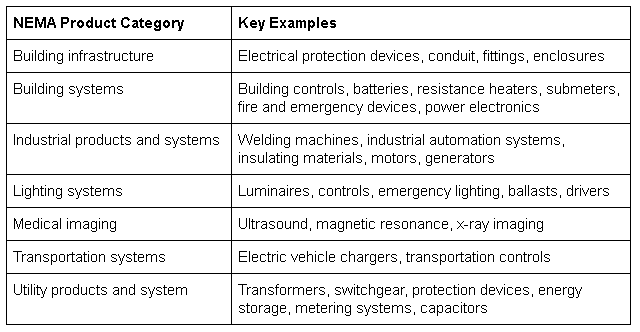The National Electrical Manufacturers Association, or NEMA, is the largest organization of electrical equipment suppliers in the US. NEMA publishes standards that establish minimum performance requirements for electrical products and have achieved international recognition and application.
Founded in 1926, NEMA has been around for almost a century. The organization now has more than 350 members, with more than 7,000 facilities and a total workforce of more than 360,000. NEMA members produce more than $106 billion a year in electrical equipment and $36 billion in exports.
It would be impossible to provide a list of all equipment covered by NEMA in this article. However, the products covered by its standards can be classified into seven broad categories:

NEMA has a technical library with more than 700 publications on electrical equipment, and 85% of its recommendations will be integrated into the 2020 National Electrical Code (NEC).
NEMA Energy Policy: A Quick Overview
Many of the standards published by NEMA address the energy performance of electrical equipment. The organization's energy policy focuses on three main aspects:
-
Energy efficient technologies
-
Rebuilding the national broadcast infrastructure
-
Enabling the smart grid
Energy efficiency provides benefits across the entire electrical supply chain. The simplest way to provide additional generation is to reduce consumption at the point of use, which frees up existing capacity. NEMA emphasizes the role of equipment standards and consumer awareness in energy efficiency.
When a building owner wants to reduce energy costs and GHG emissions, energy efficiency measures are often recommended as a starting point. In many cases, these measures can achieve a payback period of less than one year while providing long-term benefits.
Identify the best energy efficiency measures for your property.
Transmission infrastructure is needed to deliver electrical power over long distances, which may cross state borders. A poor energy grid harms growth and slows investment. NEMA considers that the current transmission infrastructure upgrade procedure is too complex and expensive and, as a result, the network cannot keep up with economic growth. They recommend updating regulations in line with the needs of modern technology and simplifying approval procedures.
The smart grid concept enhances conventional energy systems with functions such as monitoring, data analysis, automatic controls and modern communications. Smart grid technologies can make energy systems more reliable and efficient.
However, many vendors are developing smart grid technologies and they are not always compatible. NEMA considers that standardization is necessary for effective deployment of smart grid technologies as they must be interoperable. Many existing regulations that slow down investment in transmission infrastructure are also obstacles to the smart grid. Cybersecurity is also an important consideration as the number of connected devices will increase exponentially.
NEMA Standards for Construction Equipment

Some of the most relevant NEMA standards for homeowners are those that address motor efficiency and transformer efficiency.
-
NEMA premium efficiency motors can be used in pumping and ventilation systems to reduce electricity consumption. Even greater savings are possible when these motors are combined with variable frequency drives (VFD) for speed control.
-
There is also a NEMA Premium Efficiency Transformer Program. Transformers are only subject to full load occasionally and some units are never used at full capacity. However, they present permanent losses, which can be drastically reduced with the use of a higher efficiency unit.
NEMA standards also regulate the types of enclosure used by electrical equipment, and using the correct enclosure contributes to a long service life. NEMA standards also regulate the types of connectors used by outlets, which change depending on the voltage and number of phases.
The selection of electrical equipment is an important part of the design process. When a device is not suitable for its intended application, the consequences can range from poor energy efficiency to dangerous electrical failures. The best recommendation is to obtain a professional assessment from electrical engineers before proceeding with the purchase of any equipment.

